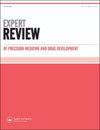A meta-analysis on diagnostic accuracy of serum HLA-G level in breast cancer
IF 1.2
Q4 PHARMACOLOGY & PHARMACY
Expert Review of Precision Medicine and Drug Development
Pub Date : 2020-03-03
DOI:10.1080/23808993.2020.1735936
引用次数: 7
Abstract
ABSTRACT Background: According to the role of human leukocyte antigen (HLA)-G in tumor progression and tumor escape from immune system as well as diagnostic role of biomarkers in breast cancer, this meta-analysis is designed to reach a pooled diagnostic accuracy for this biomarker. Methods: The present work is a meta-analysis on diagnostic accuracy studies using preferred reporting items for systematic reviews and meta-analyses guideline. All documents studying the serum level of HLA-G both in breast cancer patients and in healthy controls using receiver operating characteristics (ROC) curve with reporting area under ROC curve (AUC) were eligible for inclusion. Results: Five articles including 754 participants were eligible for quantitative synthesis. The range of AUC of the selected studies was 0.735–0.953. The pooled AUC was 0.922 (95% confidence interval [CI] 0.903–0.941) based on fixed effect model (P < 0.001) and 0.896 (95% CI 0.834–0.959) based on random effect model (P < 0.001). Conclusion: This meta-analysis updated the level of evidence for using serum HLA-G in diagnosis of breast cancer. However, this piece of evidence cannot be used as a diagnostic tool. This biomarker can be used for investigation of recurrence and response to treatment in future. Further studies are suggested to complete this evidence gap.血清HLA-G水平对乳腺癌诊断准确性的meta分析
摘要背景:根据人白细胞抗原(HLA)-G在肿瘤进展和肿瘤逃避免疫系统中的作用,以及生物标志物在乳腺癌中的诊断作用,本荟萃分析旨在达到该生物标志物的诊断准确性。方法:本工作是对诊断准确性研究的荟萃分析,使用首选报告项目进行系统评价和荟萃分析指南。所有采用受试者工作特征(ROC)曲线和ROC曲线下报告面积(AUC)研究乳腺癌患者和健康对照血清HLA-G水平的文献均符合入选条件。结果:5篇文章754名受试者符合定量综合标准。所选研究的AUC范围为0.735 ~ 0.953。固定效应模型的合并AUC为0.922(95%可信区间[CI] 0.903 ~ 0.941) (P < 0.001),随机效应模型的合并AUC为0.896 (95% CI 0.834 ~ 0.959) (P < 0.001)。结论:这项荟萃分析更新了使用血清HLA-G诊断乳腺癌的证据水平。然而,这一证据不能作为诊断工具。该生物标志物可用于研究未来的复发和治疗反应。建议进一步的研究来填补这一证据空白。
本文章由计算机程序翻译,如有差异,请以英文原文为准。
求助全文
约1分钟内获得全文
求助全文
来源期刊

Expert Review of Precision Medicine and Drug Development
PHARMACOLOGY & PHARMACY-
CiteScore
2.30
自引率
0.00%
发文量
9
期刊介绍:
Expert Review of Precision Medicine and Drug Development publishes primarily review articles covering the development and clinical application of medicine to be used in a personalized therapy setting; in addition, the journal also publishes original research and commentary-style articles. In an era where medicine is recognizing that a one-size-fits-all approach is not always appropriate, it has become necessary to identify patients responsive to treatments and treat patient populations using a tailored approach. Areas covered include: Development and application of drugs targeted to specific genotypes and populations, as well as advanced diagnostic technologies and significant biomarkers that aid in this. Clinical trials and case studies within personalized therapy and drug development. Screening, prediction and prevention of disease, prediction of adverse events, treatment monitoring, effects of metabolomics and microbiomics on treatment. Secondary population research, genome-wide association studies, disease–gene association studies, personal genome technologies. Ethical and cost–benefit issues, the impact to healthcare and business infrastructure, and regulatory issues.
 求助内容:
求助内容: 应助结果提醒方式:
应助结果提醒方式:


